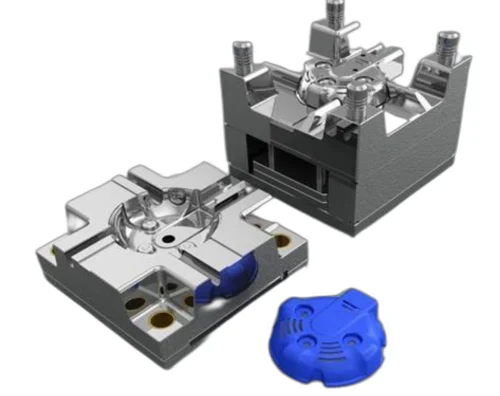Introduction: Computer-Aided Design (CAD) plays a crucial role in the development and optimization of injection molds. Injection molding is one of the most widely used manufacturing processes, particularly for producing complex and precise plastic parts. CAD tools are essential in injection mold design as they enable engineers and designers to visualize, simulate, and analyze mold designs before physical production begins. This helps in minimizing errors, reducing costs, and improving overall design efficiency.
1. Visualization of Complex Designs
One of the most significant advantages of using CAD in injection mold design is the ability to visualize intricate and detailed mold designs. Injection molds often have complex geometries that must be precisely engineered to ensure proper function. CAD allows designers to create 3D models of the mold, enabling them to view and modify designs from any angle, detect potential design flaws, and ensure that the mold will produce the desired part with minimal waste or defects.
- 3D Modeling: CAD software enables the creation of detailed 3D models of the injection mold, including components such as the cavity, core, runner system, and cooling channels.
- Design Iteration: Designers can modify the mold design quickly in the CAD system without starting from scratch, making it easy to iterate and refine the design.
2. Optimization of Mold Components
CAD tools allow for the precise design and optimization of various mold components, ensuring that the mold is not only functional but also efficient. Key components include:
- Cavity and Core Design: The cavity and core are essential parts of the mold, and CAD software helps in designing their shapes and ensuring they fit together perfectly to form the final part.
- Runner System: The runner system is responsible for directing the molten plastic into the mold cavity. CAD tools allow engineers to design an optimized runner system, ensuring balanced flow and reducing material waste.
- Cooling System: Cooling is a critical aspect of the injection molding process. CAD can help design optimal cooling channels that reduce cycle times and improve the quality of the final product.
Through simulations, designers can experiment with different design alternatives for mold components, such as the size and shape of cooling channels or the layout of runners, to ensure that the mold performs at its best.
3. Simulation and Analysis
CAD systems often come with integrated simulation tools that can simulate the entire injection molding process. This includes filling, packing, cooling, and ejection stages. By running these simulations, designers can identify potential issues before the mold is built, such as:
- Filling Simulation: This simulates the flow of molten plastic into the mold cavity and helps in detecting potential problems such as air traps, weld lines, or incomplete filling.
- Warpage Analysis: CAD software can simulate how the part will warp or distort after cooling, allowing for adjustments to be made to the mold design to minimize these issues.
- Cycle Time Prediction: CAD can help in estimating the cycle time for the molding process, which is essential for optimizing production efficiency.
4. Accuracy and Precision
CAD ensures a high level of accuracy in mold design, which is vital for the injection molding process. Even the smallest variation in mold design can lead to defects in the final part, and CAD tools help eliminate these variations.
- Dimensional Accuracy: CAD enables designers to specify exact dimensions, tolerances, and clearances for mold components, ensuring the final mold is produced as intended.
- Precision Tooling: With precise CAD data, machining and tooling operations can be done more accurately, reducing the chances of errors during manufacturing and enhancing the mold’s lifespan.
5. Collaboration and Communication
Injection mold design often requires collaboration among various teams, including design engineers, toolmakers, and production specialists. CAD enables seamless collaboration by allowing stakeholders to access and review the mold design in real time. This reduces the need for physical prototypes and enhances communication throughout the design process.
- Data Sharing: CAD files can be easily shared among team members, manufacturers, and clients, ensuring that everyone is on the same page.
- Revision Control: CAD software tracks changes made to the design, allowing teams to manage revisions effectively and avoid confusion over the most current version of the mold design.
6. Time and Cost Efficiency
By utilizing CAD in injection mold design, companies can significantly reduce the time and costs associated with the design and manufacturing process. The ability to detect design flaws early in the process prevents costly modifications to the physical mold. CAD also streamlines the workflow, leading to faster design iterations and reducing time-to-market.
- Faster Prototyping: The use of CAD enables rapid prototyping through 3D printing or CNC machining, allowing for early-stage testing and validation.
- Reduced Manufacturing Costs: With more accurate designs, there is less need for rework during the manufacturing phase, ultimately reducing production costs.
7. Integration with CAM Systems
CAD systems can be integrated with Computer-Aided Manufacturing (CAM) systems, allowing for a seamless transition from design to production. This integration ensures that the mold design is accurately translated into toolpaths for CNC machines, ensuring precise manufacturing of mold components.
- Toolpath Generation: CAD/CAM integration helps generate toolpaths automatically, which ensures that the mold is produced with high precision.
- Efficient Manufacturing: This integration reduces the need for manual input and minimizes human error, leading to a more efficient production process.
Conclusion
The role of CAD in injection mold design is indispensable. It enhances the overall design process by providing precise modeling, simulations, and optimizations. CAD allows for quicker prototyping, more accurate designs, better collaboration, and ultimately, faster time-to-market with reduced costs. As technology continues to advance, CAD systems are likely to become even more integrated with other manufacturing processes, further improving the efficiency and quality of injection molding operations.


